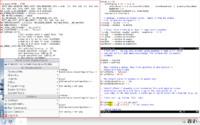Xmonad/Using xmonad in KDE: Difference between revisions
(Note about KDE desktop and applets that are separate windows in xmonad) |
(Added XMonad category) |
||
| Line 1: | Line 1: | ||
[[Category:XMonad]] | |||
Below configuration is for xmonad 0.5, known to work on Kubuntu | Below configuration is for xmonad 0.5, known to work on Kubuntu | ||
Revision as of 15:59, 8 April 2008
Below configuration is for xmonad 0.5, known to work on Kubuntu

Motivation
Easier system monitoring on laptops with networking widget.
Ability to browse all programs and utitlities with desktop bar (kicker)
Easy integration of Xmonad on a system using kdm for logins
Related reading
The GNOME/xmonad page.
Make xmonad your window manager in KDE
Create the directory ~/.kde/env if it does not
already exist. Create a file there called set_window_manager.sh
containing only the following line of text:
KDEWM=/path/to/xmonad
where "/path/to/xmonad" is the path to the xmonad
binary on your system. For example, on Debian systems this
is /usr/bin/xmonad, and if you compiled xmonad
by hand it may be something like /home/$USER/bin/xmonad.
Dealing with KDE windows
Without doing anything, you now have a working KDE environment. One nice thing is that system notification windows will pop-up as small windows in the upper left window.
KDE desktop and panel applets
The KDE desktop appears as a separate window in xmonad. Some KDE panel applets also appear as a separate window in xmonad and do not install into the panel. You may want to reserve a separate xmonad desktop for these, separate from the desktop you use for the panel itself.
Note that among the applets that appear in a separate window is the xkb applet that switches between different keyboard layouts. That allows you the flexibility of managing its location in xmonad.
Xmonad Configuration
import XMonad
import XMonad.Config
import qualified XMonad.StackSet as W
main = xmonad $ defaultConfig
{ manageHook = manageHook defaultConfig <+> myManageHook
}
where
myManageHook = composeAll . concat $
[ [ className =? c --> doFloat | c <- myFloats]
, [ title =? t --> doFloat | t <- myOtherFloats]
, [ resource =? r --> doIgnore | r <- myIgnores]
, [ className =? "Firefox-bin" --> doF (W.shift "2:web") ]
, [ className =? "Opera" --> doF (W.shift "2:web") ]
]
where
myIgnores = ["gnome-panel", "desktop_window", "kicker",
"KDE Desktop", "KNetworkManager", "KMix",
"Power Manager", "KPowersave", "klipper",
"knotes", "panel", "stalonetray", "trayer"]
myFloats = ["MPlayer", "Gimp", "kdesktop"]
myOtherFloats = ["alsamixer"]After ignoring the KDE kicker and panels, they will all be placed on the first desktop, which should be reserved for these items. It looks kind of odd, but it works.
KDE Configuration
If you don't use the KDE kicker bar much, you may want to configure the kicker bar to autohide, and show when the mouse touches the lower left corner of the screen. Right click on the bar, select "Configure Panel", select "Hiding" on the left, select "Hide Automatically", select "Raise when the pointer touches the screen's", select "Lower left Corner"